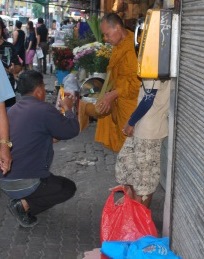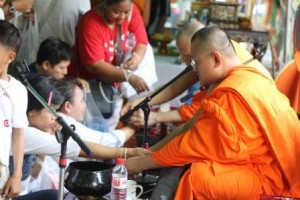In Bangkok, there are lots of monks with sons.
This statement would seem to be provocative, something meant to begin a discussion about how troubled the Sangha is (in a period when the Kingdom is itself troubled), and how it desperately needs reform. The kind of statement that begins a discussion about monks flying in private jets, or corruption over monetary issues.
Instead, it’s an innocent observation about a situation that I had never thought of. Monks can have sons. And this leads to a wider, completely obvious, observation: monks, nuns and novices, they all have families.
In 2014, I was interviewing Thai monks about their views on their own status as citizens. This was a time of protests which ended up in a coup, and while it was a time of heightened political sensitivity (which has continued), and my questions were often directly about politics, our conversations often veered into non-political areas. I wanted to know how old monks were, how long they had been monks what kind of educational background they had. This was how I learned about the sons of monks. One day in March, while walking through Lumpini Park, I encountered a monk who was in a booth collecting money for rice farmers. Lumpini is a large green space near one of the key shopping/business centers of Bangkok, and when the protests were consolidated after the failed elections of February, they ended up in Lumpini (taking away one of the few exercise areas for many residents of the City of Angels). This was not the first monk that I encountered in Lumpini, but unlike those monks, this monk was happy to speak with me about his views on politics. He admitted to me that he was not the most knowledgeable monk around, and that I should really be talking with one of the protest leaders, Luang Pho Buddha Issara, but he was happy to chat. Perhaps it was because he also wanted to test his English; this was a monk who had lived in Texas for a few years while in the military (probably as some sort of liaison between the US and Thai militaries). He told me he and his wife divorced while he was there, and that his son had remained with his ex-wife when he came back to Thailand. We kept talking for a few minutes, and then it hit me. “You have a son?” “Of course.” I asked the monk if his relationship with his son had changed, and he told me of course it had, but it also seemed that he had not seen his son since he had ordained five years prior.
This was a revelation to me – monks with sons! And it has a perfectly straightforward explanation, not at all associated with monks fathering children. Among the 120,000 or so monks in the Thai Sangha there are many who ordain after they retire, when their spouses have either died or they have gotten a divorce. This is a normal practice within Thailand and other parts of mainland Southeast Asia, though these monks tend not to have a very high status. This is because they have become monks after they have been members of society, usually though not always with spouses, children, jobs and so forth. They have been tainted, as it were, by the world; they have not spent much time in robes, and their knowledge of the teachings of the Buddha, some of these men would tell me, is not very great. (And of course they are in good company – the Buddha had a son, Rahula, before he became the Buddha.)
Over the next few weeks, it seemed, every time I went to a new wat, I encountered another old monk who was also a father. And I started asking these men about their children. Some were like the monk in Lumpini Park, telling me that their relationship with their children had changed a great deal. Others were far less willing to abandon the nature of their familial relationships. “Of course, it’s the same,” said one monk. “A father is a father; this doesn’t change when you become a monk.” He told me that he would see his son and his granddaughter regularly; there were no problems with this – the son would come and pay his respects to his father, making merit with him a couple of times a month. I suspect that their relationship did change – I know my children don’t regularly make merit to me – but perhaps less than one might expect.
The most interesting conversation wasn’t with a monk at all, but rather with the nun Bhikkhuni Dhammananda. Venerable Dhammananda has been at the center of efforts in Thailand to reestablish an order of nuns, part of wider efforts to reestablish this order throughout the Theravada world). Ven. Dhammananda was formerly a successful academic, Chatsumarn Kabilsingh who decided a number of years ago to take the higher ordination. She resides with a handful of nuns a couple of hours to the west of Bangkok at a wat that was founded by her mother. While her efforts have received some support from individual monks within Thailand, the Sangha hierarchy as a whole has said that her ordination is not legitimate, which puts her in something of an ambiguous state within Thailand. When I interviewed her in February 2014 (again about questions of citizenship), I also asked her if she had children, and how they had responded to her decision to ordain. She told me that her sons were adults, and that they supported her efforts, but also that her relationship with them had changed in radical ways. They too regularly made merit at her temple, but she could not be in a room alone with them anymore because of a need to maintain a very high standard of propriety (cue the comment about plenty of space for mediocre men in an institution, but none for mediocre women). She also said though that she and the other nuns at the wat loved to see her granddaughter. As proof of this, there was a picture of the granddaughter on the side of the wat’s refrigerator.
When I conducted research on Theravada, minority monks of Southwest China in 2001-2002, I was accompanied by my wife and our now 15 year old son who was one at the time. He fascinated the monks and the novices of the wat. They would play with him every day after I taught English to the novices – they even threw his first birthday party, making him cry when they sang Happy Birthday (see the picture). When I have returned to the region, even after a decade, the monks ask how he was doing and if he remembered them.
One day in spring 2002, when the abbot and I were chatting and watching the novices play with my son, he sighed and said, “Children, they are lovely…but they are dukkha,” using the term that is part of the “first truth” of Buddhism, that suffering or dis-ease is an inevitability in existence. This seemed a curious thing to say at the time, because the abbot was as likely to play with my son as the novices were (if not quite as boisterously). I don’t know why he mentioned this, but I do know that for many years, the abbot (a figure who has “left home”) supported his younger sister and her children after they had come to Southwest China from the Shan States in Myanmar. While not a father, perhaps he was feeling a little too clearly the difficulties that familial attachments inevitably cause.
The abbot’s comment is one that we have come to expect from the monastics of Buddhism. After all, it conforms with the ideal that we find in a number of Pali texts such as the Khuddaka Nikaya which talks of monks “wander[ing] alone like a rhinoceros,” or the Dhammapada: “Better it is to live alone; there is no fellowship with a fool. Live alone and do no evil; be carefree like an elephant in the forest.” (trans. By Acharya Bodhirakkhita, 1985; accessed at www.buddhanet.net). This also fits nicely into Weber’s influential framing of Buddhism as “other-worldly asceticism.” It is also, if not wrong, at least too limited a way of looking at Buddhist religious specialists, confusing an ideal within Buddhism with the ideal.
Why does this matter (beyond the fact that I have a bit better sense of the experience of Thai Buddhists)? There are two points here. First scholarly work in English on monastics and families has been insufficient. Gregory Schopen twenty years ago drew our collective attention to how inscriptions showed monastics dedicating merit to their parents. More recently Shayne Clarke’s (2014) Family Matters in Indian Buddhist Monasticisms reading of disciplinary commentaries tells us that family relations inside and outside the monastery were of significant concern, and there is a special issue of the Journal of Global Buddhism (released a few weeks ago) which is dedicated to the “Family in Modern Buddhism.” While this work is welcome, it is really focused on pre 20th century Buddhisms, or on Japanese forms which have a long history of clerical marriage. Indeed, with the exception of a chapter on monastic recruitment in Jeffrey Samuels’ important book on emotion in Sri Lankan monastic culture, Attracting the Heart, there has been no attention to the position of Theravada monks in the contemporary world as members of families (let alone as fathers).
This insufficient scholarship points to a problem with the way we have framed our interests in monks and nuns as actors, no doubt. But I suspect that there is a broad reluctance within the Thai world (and indeed perhaps the Theravada world more broadly) to talk about the ways that monks remain imbricated within family relations, and certainly with the ways that they could be fathers. The status of monks as sons is clear and obvious since the merit of ordination is often dedicated to one’s parents. And Thais are certainly aware that monks can be sexual beings, and were before they ordained, but that sexuality is a problem to be resolved or repressed once one has taken on robes. Moreover, structurally, monks have left the family, even if they still communicate with their family members regularly. Most of the monks I have talked to in Thailand (and indeed in China as well) are willing to answer questions about their families, but they rarely bring them up in the course of a conversation. In other words, while these “monks with sons” are nothing out of the ordinary, they are a subject about which Thai Buddhists are generally silent.
So let me modify my opening statement. There are monks with sons in Bangkok, but I don’t know if there are a lot of them, or if this is a significant phenomenon or not. However, because of scholarly inattention and internal silences, no one else does either.






